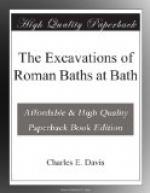After these discoveries of the middle of the last century but very partial excavations were made in proximity to the baths, and those that were made were never sunk to a depth sufficient to reach the ruins. The flood of hot water had no drain to carry it off, and was maintained at such a height in the soil that whenever a sinking was made, it was impossible without pumping machinery to sufficiently overcome it. To my discovery of the Roman drain, or rather to Mr. Irvine’s, and the excavating, opening, and reconstructing it which followed (under my superintendence, at the charges of the Corporation), enabling me to drain off the hot water from the soil, I owe the ability to reveal what had been hidden since the destruction of the city of Bath in the year A.D. 577.[10] The stopping up and destruction of the drain prevented the water from flowing away, so that the buildings of the baths were filled with water of a height until it reached the level of the adjoining land, covering, as a guardian, the lead and other valuables. Soil then gravitated into the ruins and thus further assisted in preserving the antiquities, so that they were altogether hidden from the people who re-built the ruined city of Bath, and from those who in successive generations succeeded them. The subterranean “passage traced 24ft.” from the western side of Lucas’s bath, “at the end of which was found a leaden cistern,” was not in any way Roman work, but mediaeval, and was formed some time after the construction of the Abbey house, as an aqueduct for the hot water with which the soil was saturated. This construction is the only evidence of an early discovery of this eastward wing of the bath, indeed the only evidence of mediaeval work of any kind in connection with the baths, except the enclosure of the various springs or wells. The King’s Bath, the Cross, and the Lepers’ Bath were simply the wells or cisterns of the springs which were bathed in to the damage of the purity of the water, without dressing-rooms of any kind.
[Footnote 10: “But the old municipal independence seems to have been passing away. The record of the battle in the chronicle of the conquerors connects the three cities (Bath, Gloucester, and Cirencester) with three Kings; and from the Celtic names of these Kings, Conmael, Condidan, or Kyndylan, and Farinmael, we may infer that the Roman town party, which had once been strong enough to raise Aurelius to the throne of Britain, was now driven to bow to the supremacy of native chieftains. It was the forces of these Kings that met Ceawlin at Deorham, a village which lies northward of Bath, on a chain of hill overlooking the Severn valley, and whose defeat threw open the country of the three towns to the West Saxon army.”—Green’s “Making of England," p. 128.]




